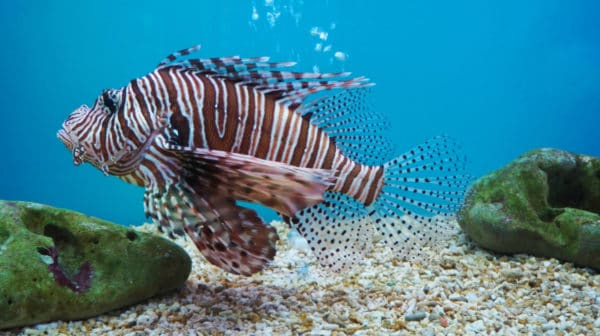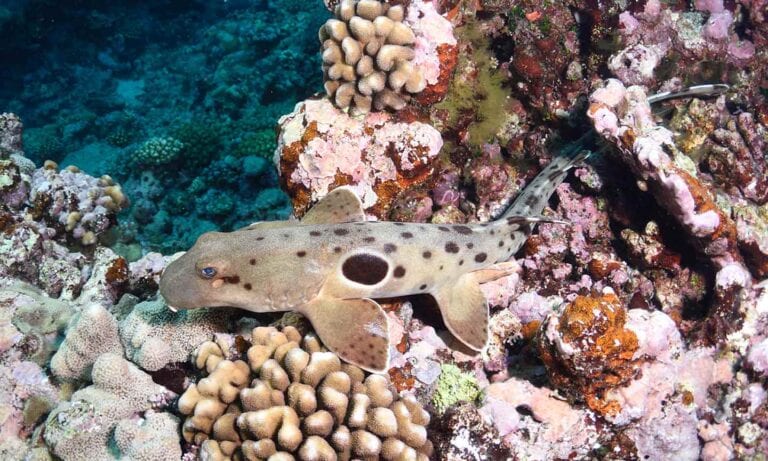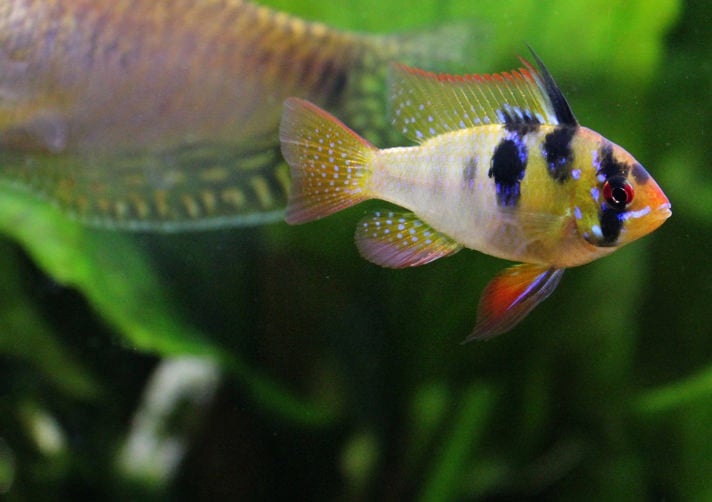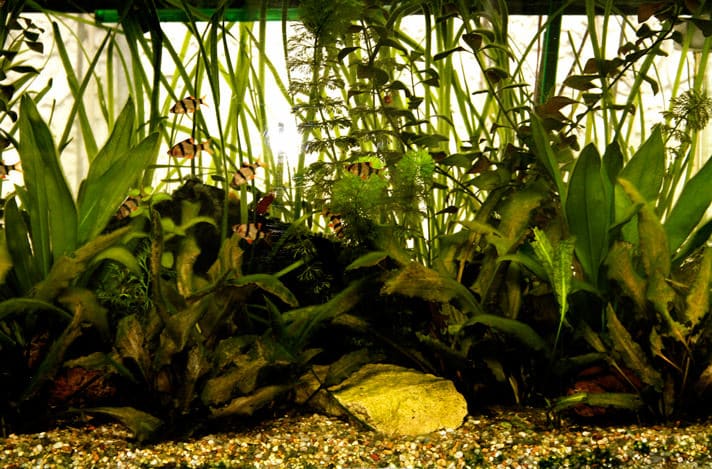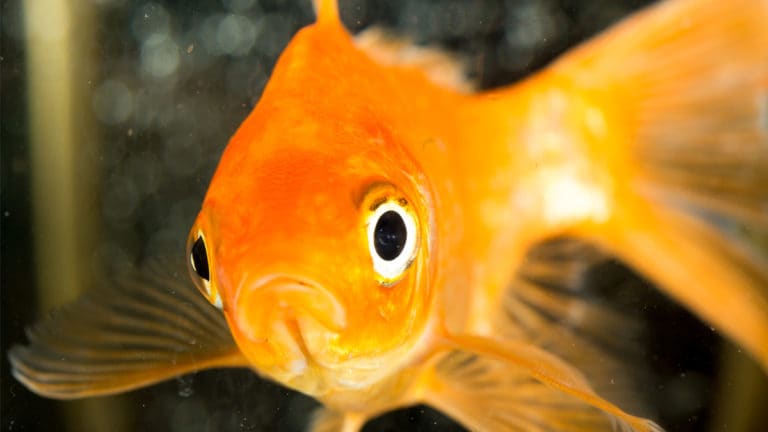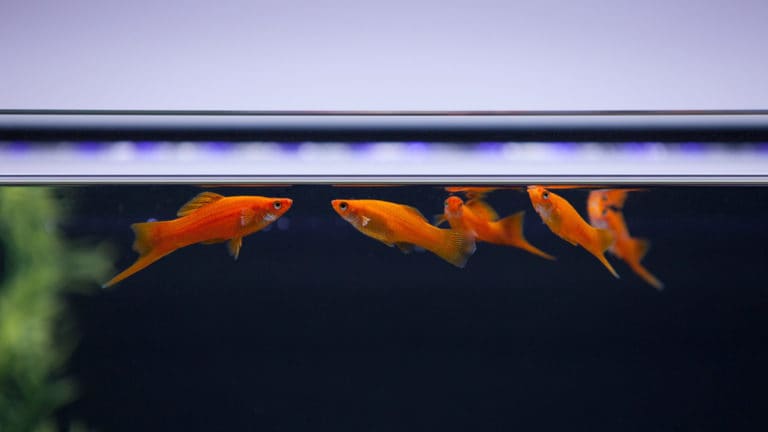Certain fish could be considered icons of the marine aquarium hobby. A short list of saltwater “celebrities” would vary at least a little among experienced aquarists, but one species that would no doubt be near the top of this list is the volitans or common lionfish. When I worked at a retail fish store, I sold many of these fish and encountered many people who set up saltwater tanks because they fell in love with this ornate creature.
The volitans lionfish is not the only amazing member of the subfamily Pteroinae, a group of fish known collectively as lionfish (or less often as turkeyfish, firefish or butterfly cod). There are a number of lionfish species that enter the fish aquarium trade. Although most are considered to be relatively durable aquarium fish, some are more demanding than others, and all require some special care if they are going to thrive in captivity.
In this article, I’ll use a question and answer format to share information on this remarkable group of fish. These are questions that hobbyists have asked me over the years.
How many species of lionfish are there?
Lionfish are members of the family Scorpaenidae (scorpionfish) and the subfamily Pteroinae. There are six genera in this subfamily, and approximately 22 species. See “Lionfish Species” to the right for a list of the species in this subfamily. The fish you most often see in the aquarium trade belong to two genera: Dendrochirus and Pterois.
There is some debate as to the validity of some of the species in the genus Pterois. This is especially true for members of the volitans species complex. There are a number of species in this group that are very similar, including the Kodipungi, Japanese, Indian, Russell’s, longspine and, of course, volitans lionfishes.
These species are thought to differ in one or more of the following characteristics: dorsal spine length, markings on the median fins and number of fin spines. It is thought that P. volitans is found in the Pacific Ocean, whereas the Indian Ocean form is actually a distinct species known as P. muricata.
How do the two species differ? The Indian lionfish has one less ray in the dorsal and anal fins, and the pectoral fin rays are slightly shorter than those of P. volitans. Do not confuse P. muricata with P. miles (a name formerly used for the Indian Ocean form of P. volitans). Pterois miles is a separate, rare species apparently limited to murky coastal habitats in the northern Indian Ocean. These are subtle differences that most aquarists will not notice.
How venomous are lionfish?
As mentioned, the lionfish are members of the scorpionfish family. These fish get their name from their venomous dorsal, pelvic and anal fin spines. These spines are like hypodermic needles; each spine is connected to a venom sac situated in the dorsal musculature of the fish. When these spines penetrate the flesh of another fish or human, venom is injected through a groove in the spine.
On a recent trip to the Philippines, I made the mistake of placing my finger on the dorsal fin of a shortfin lionfish (D. brachypterus). The resulting envenomation was similar to a bee sting, and the pain was relatively short lived. That said, I know someone who was stung on the thigh by a large volitans lionfish and ended up on the deck of the boat writhing in pain. In this case, the pain lasted for hours. Zoologist H. Steinitz was stung on the finger by a 4-inch P. volitans. Regarding this sting, he said, “I was tortured by pains beyond measure, and yet the pain was still growing more intense. It is just short of driving oneself completely mad.”
The most common symptoms associated with lionfish stings are intense pain in the affected area and swelling. The pain subsides as treatment is administered, and in most cases subsides within 24 hours. More serious envenomation may include weakness, shortness of breath, nausea, vomiting, delirium, fever, chest and abdominal pain, and even unconsciousness.
The severity of an envenomation event may depend on the species and the size of the lionfish. I have not been able to find any information indicating if toxicity of the venom of various species differs, but as in venomous snakes and scorpions, this could be the case. It would also make sense that a larger lionfish may inject a large quantity of venom. In very rare cases, lionfish stings have caused death.
Therefore, make sure you treat your lionfish with the utmost respect!
What do I do if I get stung by my lionfish?
If you are stung by your lionfish, immediately immerse the wound in hot, nonscalding water (from 110 to 113 degrees Fahrenheit for 30 or 40 minutes or until pain has diminished), or heat it with a hair dryer. The heat will denature the protein that constitutes the venom and prevent it from spreading through your body. If the aforementioned symptoms occur, it is advisable to seek medical attention immediately.
How are most aquarists stung by lionfish?
Although there are fanciful stories in the old aquarium literature of lionfish dashing across the tank to stab their human keepers, the venomous dorsal spines of lionfish are used primarily for defensive purposes. There are situations in which at least certain species of lionfish employ their spines in an offensive manner. When fighting for females, male lionfish (especially Dendrochirus spp.) regularly spar using their dorsal spines to inflict damage to their rivals. Although it is unlikely your lionfish will “attack” you, they will raise and direct their spines toward a potential threat, and this could include a hand moving in the aquarium.
In most cases of lionfish stings, aquarists are stung while cleaning the tank or transferring a lionfish from one tank to another. The preoccupied aquarist accidentally bumps or brushes into the lionfish’s needle-sharp dorsal spines. In order to prevent envenomation, be vigilant when working in a lionfish’s aquarium.
Many lionfish hide behind pieces of fish tank decorations and can easily go unnoticed. Locate these fish before cleaning the tank to prevent accidental contact. Also, you should never place your hand or arm too near a lionfish’s dorsal spines, because if they perceive you as a threat, they can arch their backs and thrust their dorsal armament forward to jab you.
What and when do lionfish eat in the wild?
The diets of lionfish vary among genera and species. Studies have shown that members of the genus Dendrochirus feed mainly on crustaceans, while Pterois species (especially the larger, more active members of the genus) include more fish in their diet. For example, adult volitans lionfish feed more heavily on fish than most other members of the genus, but crabs and shrimp (including the banded coral shrimp, Stenopus hispidus) are also important in their diet. With larger Pterois, studies suggest that crustaceans are also more important in the diets of juveniles than adults.
Most lionfish feed at dusk or in the dark. For example, the spotfin lionfish emerges from its daytime hiding place (usually a crevice or a cave), and begins to hunt shrimp and crabs in the late afternoon. It continues these hunting forays into the night. The volitans lionfish and some of its close relatives are more likely to feed during the day than their more secretive relatives. For example, in Japan, I often saw large Japanese lionfish strike at cardinalfish that moved too far from cover in the early mornings.
Some lionfish may engage in cooperative hunting; individuals will work together to increase their chances of hunting success. Groups of volitans lionfish will herd schools of small baitfish up against the reef, isolate a smaller group, then launch their attacks. In Papua, New Guinea, I observed a fascinating example of P. volitans’ cooperative hunting behavior in Milne Bay. It occurred on a barren sand slope, where there were solitary and clustered venomous sea urchins (Astropyga radiata). These urchins were with the commensal urchin cardinalfish Siphamia versicolor. At dusk, I observed three large volitans lionfish surrounding a solitary urchin. The cardinalfish would retreat from one side of the urchin to the other to get out of the path of the nearest lionfish – but when it did, it would swim into the strike zone of one of the other waiting predators.
Do lionfish need live feeder fish?
Although it can be interesting to observe lionfish consuming feeder fish, feeder fish do not provide a nutritionally complete diet. It may be necessary to feed your lionfish live food initially, such as live ghost shrimp, fiddler crabs, freshwater crawfish, feeder guppies, mollies, or even cardinalfish or damselfish. Unfortunately, many aquarists feed their lionfish live feeder goldfish.
This is probably the worst possible choice. Raw goldfish flesh contains thiaminase, an enzyme that causes the breakdown of thiamin. If you feed your lionfish a diet that consists only of goldfish, they may become thiamin deficient. This can result in feeding cessation, clamped fins and problems with the nervous system. Yes, I have seen lionfish kept a number of years and fed only live feeder fish, but you are more likely to have success if you do not feed your lionfish live feeder goldfish. I prefer feeding live ghost shrimp to newly acquired lionfish. Before you introduce the shrimp to the lionfish tank, feed these crustaceans a nutritious frozen prepared food. Then, feed the shrimps to your lionfish. This is known as “gut packing”; you are packing the guts of the shrimp with nutrients that will be passed on to the predator consuming the shrimp.
Although some species are reluctant to accept anything but live food, you should attempt to switch your lionfish to nonliving food. One of the easiest ways to do this is to take a piece of marine fish flesh or a piece of fresh shrimp, and make it “swim” around the tank by attaching it to the end of a piece of rigid air line tubing. There are other ways to dupe your lionfish into taking onliving food – just use your imagination.
How often should I feed my lionfish?
In the wild, a lionfish will consume from one to more than 10 small- to medium-size prey items per day. In the aquarium, it is preferable to feed your lionfish two or three times a week, depending on the temperature of the aquarium (at lower water temperatures, you will not need to feed them as much). If you feed a captive lionfish too much or do not vary the diet, fatty degeneration of the liver may occur. This condition can cause liver failure, which leads to suppression of the immune system, hemorrhaging and anemia.
It is thus important to vary the diet and not to feed your lionfish too much. It is also important not to feed your lionfish large prey items. These fish have been known to kill themselves by overeating. You should feed larger amounts of small prey items rather than one large morsel.
Which lionfish are most difficult to keep?
In my opinion, the most demanding species is the twinspot or Fu Manchu lionfish (Dendrochirus biocellatus). This species is very secretive and can be difficult to feed, especially if kept in a larger aquarium and/or housed with aggressive food competitors. I prefer to keep this species on its own in a smaller tank (20 or 30 gallons). You will need to feed it live ghost shrimp to initiate feeding and may have to continue feeding it live food because it is more difficult to switch to nonliving foods. In general, members of the genus Dendrochirus require a little more attention, especially when it comes to feeding, than Pterois.
What kinds of fish can be kept with them?
Keep lionfish with fish tankmates too large to eat. Lionfish swallow their prey whole, so as long as a fish is too large to swallow, it will typically be ignored by lionfish. That said, know that some lionfish can eat relatively large prey. This is especially true of fish that are longer in body shape, such as certain wrasses and gobies.
Deep-bodied fish, such as angelfish and butterflyfish, are less attractive targets. Although lionfish rarely sting fish tankmates, this can occur. This is more likely to happen with less agile tankmates, like other scorpionfish, puffers and porcupinefish. These fish have been known to accidentally land on or ram into lionfish spines.
While their venomous spines are effective for dissuading some predators, lionfish still have their enemies. I have had frogfish eat lionfish that were as long as they were, and there are reports of sharks, coronetfish and groupers eating lionfish. I have also seen larger angelfish, triggers and puffers nip at lionfish fin spines. Just because lionfish have a potent defense system does not mean they are invincible to attacks by other fish.
Can I keep more than one lionfish in the same tank?
Some lionfish will behave aggressively toward members of their own kind. For example, twinspot and shortfin lionfish have been known to chase one another – incessantly, in some cases. The submissive fish (the one being chased) will often stop feeding and may perish if not removed from the aquarium. Many Pterois tend to be more tolerant of their own species, as well as other lionfish species.
When placing more than one lionfish in the same tank, it is best to add smaller individuals first. Of course, problematic aggression is also less likely if the tank is larger. When keeping lionfish together, make sure you spend time watching them. If an individual is harassing others, you will need to remove the aggressor or those individuals getting picked on to ensure their survival.
Aggressive encounters between lionfish are typically limited to lateral displays, gill cover flaring and head shaking. If one individual does not back down, the combatants may bite each other. For example, an aggressive shortfin lionfish may grasp the head of an opponent in its mouth and vigorously shake it from side to side. This behavior can result in damage to the jaws of the fish that is attacked. Individuals may also bite the flanks of a species member. Some lionfish will ram each other with their venomous dorsal spines.
Although a lionfish stung by a species member will usually not die as a result, it can cause temporary distress, including an increased respiration rate (as much as three times its normal rate) and decreased swimming activity. I have also seen Dendrochirus lions in the wild that were missing eyes, which I would guess was the result of spines poking into them.
Can lionfish be kept in a reef aquarium?
Yes! Lionfish can make attractive and interesting additions to a reef aquarium. They will not harm sessile invertebrates, such as sponges and corals, but they are a threat to ornamental crustaceans. So, if you decide you can live without a cleaner shrimp or anemone crab, a lionfish is an ideal addition to a reef tank. You can keep larger hermit crabs (too big for your lionfish to swallow) with lionfish, but they may eat small hermits. Of course, a lionfish is likely to ingest any fish that can fit in its mouth. Although lionfish are not for everyone, they can be attractive and very interesting inhabitants in a fish-only or reef aquarium. Be sure you are aware of the risks involved as a lionfish owner (especially if you have small children at home), and be prepared to spend some time ensuring they get enough of the right foods. Until next time, happy fishwatching!
Posted by: Chewy Editorial
Featured Image: Jetsita/Shutterstock
Share:
